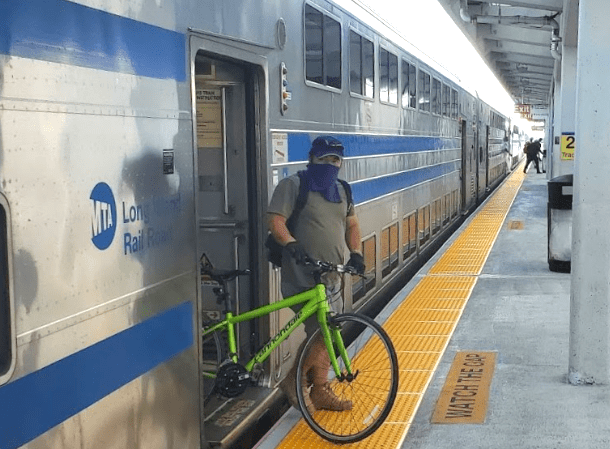OPINION: Connecting Cyclists and E-Scooter Users With the MTA
The authority could do much — right now and fairly cheaply — to help active-transportation users make first/last mile connections with transit.

Gov. Hochul has a bill on her desk that requires the Metropolitan Transportation Authority to create a strategic action plan in order to bolster cycling and pedestrian access on MTA bridges and at passenger stations. She should sign it immediately.

The legislation, however, is only the beginning of the work that the MTA must do in order to make its services accessible to a variety of users and to encourage the integration of active-mobility devices with mass transit.
The MTA recently repealed its requirement that passengers using its Long Island Rail Road and Metro North trains obtain permits for bringing their bicycles onboard — signaling a clear change in the agency’s decades-long unfriendly attitude toward accommodating transit customers who bike. Yet, despite the fanfare that attended the change, it remains unclear whether it represents a true step toward more equity and accessibility or mere political lip service.
The MTA doesn’t need to spend a lot of money or do elaborate studies in order to make bicycling to transit a viable, safe and accessible alternative to driving. Here’s what it can do — now — to help active-transportation users make first/last mile connections with transit:
Developing data: The best way to adapt to changing mobility patterns is to understand how barriers to cycling affect transit customers and the behavior of cyclists. The MTA’s suburban services, the Long Island Rail Road and Metro North Railroad, should look to peer transit agencies across the country and in Europe in order to develop performance indicators and measurements to track bicycle mobility in relation to transit. Agencies including Bay Area Rapid Transit, LA Metro and Sound Transit all track bicycle mobility as a feeder for transit and could supply New York Metro-applicable metrics and tracking methodologies.
Secure bike parking at transit stations: Ensuring availability and security of bikes at transit facilities is critical to realizing the potential of bicycle connections with transit. The MTA will need to invest in secure-access bike rooms or cages with weather protection, many more than the baby steps it is taking by piloting a six-bike Oonee mini pod at Grand Central Terminal. The Port Authority of New York and New Jersey is far ahead of the MTA on this score, with full-sized Oonee pods coming to several locations.
Local jurisdictions often control stations and parking facilities, but the MTA could easily develop a toolkit to help educate towns, villages, hamlets and cities to understand the merits of bike parking, and provide resources for planning and implementation. The MTA could also pilot secure bike-parking facilities at select stations of varying scales in its system in order to test the concept and develop preliminary data (maybe even leveraging OMNY for a seamless user-payment experience).
Better bike storage onboard: At a bare minimum, MNR and LIRR trains should have designated bike racks onboard each passenger car in a separate area from Americans With Disabilities Act seating. This simple practice, coupled with decals on the exterior of the cars, would help cyclists navigate more efficiently and minimize conflicts with other passengers both onboard and on the platform.
Integrated fare payment for micromobility (and more): According to 2020 global ridership data from Lime, one in five trips connected with transit. This is an indicator of a clear connection between micromobility and greater transit ridership. By integrating Citi Bike and other shared-mobility operators with its new OMNY payment platform, the MTA could open the door to a seamless user experience — stoking transit ridership and shifting commuters away from driving.
The MTA could even take such integration a step further, by installing secure bike cages with OMNY-activated access (as many other transit agencies, such as LA Metro, have done). The recent launch of Lime, Bird and Veo electric scooters in the Bronx also presents another opportunity to leverage integrated fare payment and connect micromobility users with lower density areas of the subway system and Metro North stations.
As we eagerly wait for Hochul to codify an advisory board to bolster first/last mile connections with transit, these simple, cost-effective measures could pave the way for a more integrated and sustainable approach to regional mobility. Leaning into bicycle transportation will help the MTA extend the reach of its transit system, and in turn, bolster equitable access and ridership.
Dan Suraci (@bikinghero), a certified planner, wrote the American Public Transportation Association’s national guide on bicycle and transit integration. He serves as Lime’s senior manager of market development, and is the president of Urban Cycling Solutions.